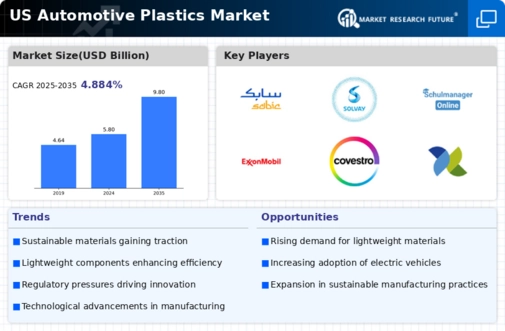The automotive plastics market is currently characterized by a dynamic competitive landscape, driven by innovation, sustainability, and technological advancements. Key players such as BASF (DE), DuPont (US), and Covestro (DE) are actively shaping the market through strategic initiatives aimed at enhancing their operational capabilities and market presence. BASF (DE) focuses on developing high-performance materials that cater to the evolving demands of the automotive sector, while DuPont (US) emphasizes its commitment to sustainability by investing in bio-based plastics. Covestro (DE) is leveraging its expertise in polycarbonate materials to create lightweight solutions that improve fuel efficiency, thereby aligning with the industry's shift towards greener technologies. Collectively, these strategies contribute to a competitive environment that prioritizes innovation and sustainability.
In terms of business tactics, companies are increasingly localizing manufacturing and optimizing supply chains to enhance efficiency and responsiveness to market demands. The competitive structure of the automotive plastics market appears moderately fragmented, with several key players exerting influence over various segments. This fragmentation allows for a diverse range of products and innovations, fostering a competitive atmosphere where companies must continuously adapt to maintain their market positions.
In October 2025, BASF (DE) announced a partnership with a leading automotive manufacturer to develop a new line of sustainable plastic components aimed at reducing the carbon footprint of vehicles. This collaboration underscores BASF's strategic focus on sustainability and positions the company as a frontrunner in the development of eco-friendly materials. The partnership is likely to enhance BASF's market share while addressing the growing consumer demand for environmentally responsible products.
In September 2025, DuPont (US) launched a new bio-based polymer designed specifically for automotive applications, which is expected to reduce reliance on fossil fuels. This strategic move not only aligns with global sustainability goals but also enhances DuPont's product portfolio, allowing it to cater to a broader range of automotive manufacturers seeking sustainable solutions. The introduction of this polymer may significantly impact DuPont's competitive positioning in the market.
In August 2025, Covestro (DE) expanded its production capacity for polycarbonate materials in North America, responding to the increasing demand for lightweight automotive components. This expansion is indicative of Covestro's commitment to meeting market needs and enhancing its operational efficiency. By increasing production capabilities, Covestro is likely to strengthen its competitive edge and better serve its customers in the automotive sector.
As of November 2025, the automotive plastics market is witnessing trends that emphasize digitalization, sustainability, and the integration of artificial intelligence. Strategic alliances among key players are becoming increasingly prevalent, facilitating the sharing of resources and expertise to drive innovation. The competitive differentiation is expected to evolve, shifting from traditional price-based competition to a focus on technological advancements, innovative materials, and reliable supply chains. This transition suggests that companies that prioritize innovation and sustainability will likely emerge as leaders in the automotive plastics market.






















Leave a Comment